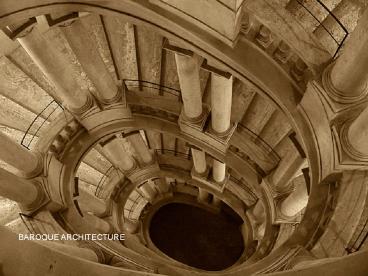BAROQUE ARCHITECTURE PowerPoint PPT Presentation
1 / 42
Title: BAROQUE ARCHITECTURE
1
BAROQUE ARCHITECTURE
2
Baroque architecture An Architecture of the
Senses 17th and early 18th centuries Rome and
Paris Deliberate complexity Ambiguity instead of
clarity Studied variety instead of
uniformity Contrast instead of regularity Emphasis
on spatial depth and plasticity over planar
quality Emotional impact over intellectual
comprehension Renaissance, classical orientation
of architecture Through mathematical and rational
understanding of geometry and proportion in
architecture Also followed by increasing degree
of personal interpretations maniera Maniera,
affectation and deliberate stylizations Ingenious
inventions to caprices. Baroque, from the
Portuguese word, barocco, misshapen pearls Borne
out of a critique of architecture especially in
Italy in the 18th century
3
The emergence of the Baroque points to an older
history in architecture of the tension between
restrained and the visually exuberant, as in the
Hellenic versus the Hellenistic Reformation and
Counter-Reformation in the Christian
Church Precipitated in the 16th c. by the
struggle in Christianity between Protestant
Reformation and the Roman Counter-Reformation, tha
t is, between the elimination of the sensory
stimulation in worship as directed by the
Protestants versus the Catholic
Counter-Reformation insistence on music,
painting, sculpture and architecture as
powerful instruments enhancing architecture. The
Council of Trent (1545) encouraged the use of
architecture, painting and sculpted images to
create a mystical, supportive atmosphere
for worship. A new spirit of dynamicity and
aggressiveness ensued. Baroque art and
architecture was a response to the
Council Structural system obscured for more
intricate pattern of light and shadow, no part
of surface left without embellishment, where the
eye is drawn endlessly from part to part. The
reality of three-dimensionality and mystical
illusion blurred. Architecture from an
independent art becomes part of a grand vision of
the fusion of all the arts. Baroque architecture
also became a celebration of absolutism,
especially in the case of France and its absolute
ruler. Concentration of power in individual in
changing social and political system.
4
Raphael, The School of Athens (1508)
5
Inigo Jones, Banqueting Hall
Painting by Belloto
6
Sansovino, Bacchus
7
Michelangelo, Pieta
Caravaggio, Entombment
8
Bernini, Saint Teresa in Ecstasy
Bernini, Four Rivers Fountain
9
Mannerism as practiced by Michelangelo Complexit
y Variety (license) Difficulta (heroic struggle
to achieve infinity) Capacity to excite wonder
Michelangelo, Porta Pia, Rome
10
Michelangelo, Laurentian Library, Rome
11
Michelangelo, Tomb of Guiliano de Medici
12
Michelangelo, Sistine Chapel
13
Baroque art and architectural features Exuberant
forms and spaces joyous and emotional
mood Architecture of the senses direct
appeal to the senses Generation of movement
swirling compositions figures in strong
movement dramatic gestures Sculpturesque
treatment of architecture Theatrical effects
Rhetorical goal aim to arouse astonishment
to impose instantly Integration of painting,
sculpture and architecture Blurring of
three-dimensional reality and visual
illusion Large-scale operation in urban design
Pietro de Cortona, Truimph of the Barberini
14
El Greco, View of Toledo (1610)
15
Bernini, Saltcellar of St. Francis I
16
Bernini
17
Corregio, Assumption of the Virgin
18
De Vignola and Giacomo della Porta, Church of Il
Gesu, Rome (1568)
19
(No Transcript)
20
The oval plan exalts Keplers planetary
model Oval as evolving form Combining
longitudinal space with dome No singular visual
focus Façade not organically tied to interior A
magnificent showpiece of movement caused by
undulation and light and shadow
Francesco Borromini, San Carlo alle Quattro
Fontane Rome (1665)
21
(No Transcript)
22
(No Transcript)
23
(No Transcript)
24
(No Transcript)
25
(No Transcript)
26
Francesco Borromini, Church of Sant Ivo della
Sapienza Rome (1642)
27
(No Transcript)
28
(No Transcript)
29
Francesco Borromini, Sant Agnese in Piazza
Navona Rome (1653)
30
(No Transcript)
31
Gian Lorenzo Bernini, Church of Sant Andrea al
Quirinale Rome (1658)
32
St. Peters, Rome
33
Overall design and large-scale urban
strategies Absolute perspectives Controlled
views Oval as geometric generator Monumentality Ax
es of movements
Bernini, Piazza of St. Peters Rome (1656)
34
Altar, Cornaro Chapel
Bernini
Baldacchino, St. Peters
35
(No Transcript)
36
John Balthazar Neuman, Church of
Vierzehnheiligen Germany (1743)
37
Mirror Room, Munich (1734)
38
Neuman, Imperial Hall, Warzburg
Neuman, Church
39
Bronzino, Martyrdom of Lawrence
40
Louis XIV and Versailles
41
John Vanbrugh, Blenheim Palace, England (1705)
42
(No Transcript)

